Blog
Seoul’s Must-Visit Checklist: Unforgettable Spots
Discover Bleisure
A Checklist of Must-visit Spots in Seoul
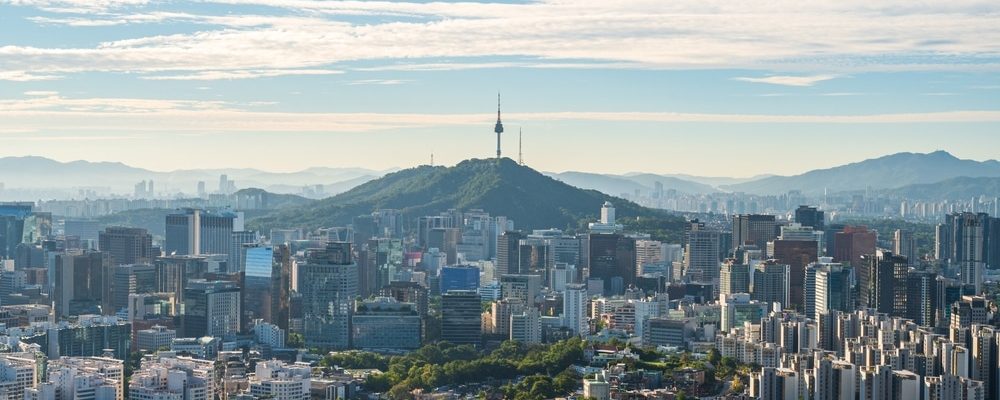
Please click the hashtags below to find out more!
Exploring the Joseon Dynasty
#The Five Grand Palaces of Seoul
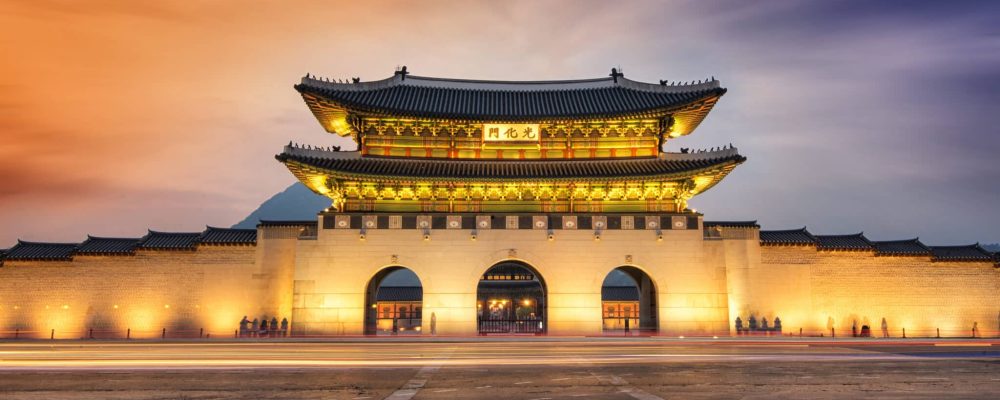
Immerse Yourself in the Rich Heritage of the Joseon Dynasty: Explore Seoul’s Historic Palaces in Hanbok
For travelers yearning to step back in time and uncover the captivating legacy of the Joseon Dynasty, a visit to Seoul’s historic palaces is an absolute must. This era predates the modern Republic of Korea, and by donning hanbok, the traditional Korean attire available for rent at numerous stores near the palaces, you can unlock a unique experience. Not only will you gain free entry to all five palace locations, but you will also elevate your visit with unforgettable moments and stunning photographs.
Seoul’s palaces are steeped in history, each with its own distinct charm and architectural marvels. By adorning hanbok, you not only pay homage to the past but also seamlessly blend in with the timeless beauty of these historical sites. The vibrant colors and intricate designs of hanbok will add an aura of authenticity to your exploration, making your journey through the palaces truly immersive.
Gyeongbokgung, Changdeokgung, Changgyeonggung, Deoksugung, and Gyeonghuigung are the five magnificent palaces that invite visitors to relive the splendor of the Joseon Dynasty. With your hanbok, you’ll have the freedom to wander through the palace grounds, admiring the grandeur of the architecture and lush gardens. Capture breathtaking photos against the backdrop of the palace’s regal halls, pavilions, and ceremonial gates, creating treasured memories that will last a lifetime.
Beyond the physical beauty, wearing hanbok also allows you to connect with the traditions and customs of the past. As you explore the palaces, you’ll gain a deeper understanding of the royal lifestyle, the elegant court rituals, and the profound cultural heritage that shaped Korea. It’s a rare opportunity to immerse yourself in the rich tapestry of history and truly appreciate the significance of these remarkable sites.
Seoul’s historic palaces are not merely static museums but living, breathing testaments to the nation’s glorious past. By embracing the spirit of the Joseon Dynasty through hanbok, you’ll embark on a journey that transcends time, enriching your travel experience and leaving you with cherished memories. So, seize the opportunity to explore these extraordinary landmarks in the heart of Seoul, dressed in the traditional attire of hanbok, and unlock the secrets of Korea’s captivating history.
Gyeongbokgung Palace
Gyeongbokgung Palace, constructed in 1395, stood as the principal royal residence throughout the Joseon Dynasty’s history. Among Seoul’s Five Grand Palaces, it reigns as the largest and most splendid, epitomizing traditional Korean architecture, landscaped beauty, and the esteemed royal culture. Within its majestic grounds, visitors can explore the National Palace Museum of Korea and the National Folk Museum, which exhibit a captivating collection of historical artifacts, providing insights into the daily life of that era. Gyeongbokgung Palace stands as a testament to Korea’s rich heritage, offering an immersive journey back in time to experience the grandeur of the Joseon Dynasty.
- Address
- 161 Sajik-ro, Jongno-gu, Seoul (Gyeongbokgung Station, Exit 5)
- Website
- www.royalpalace.go.kr
- Inquiries
- +82-2-3700-3900
Gyeonghuigung Palace
Gyeonghuigung Palace, founded in 1617, was the primary royal residence for ten Joseon Dynasty kings. Although once an expansive complex with over 100 buildings, the palace suffered during the Japanese colonial period, leaving only a third of its original structures intact. Notable surviving elements include the iconic Heunghwamun main gate and the Hwanghakjeong pavilion in the rear garden. Visitors with an interest in history and culture can also explore the Seoul Museum of History located within the palace grounds. Gyeonghuigung Palace provides a captivating glimpse into Korea’s past, allowing you to witness remnants of its former magnificence.
- Address
- 55 Saemunan-ro, Jongno-gu, Seoul (Gwanghwamun Station, Exit 7)
- Inquiries
- +82-2-724-0274
Changgyeonggung Palace
Changgyeonggung Palace, commissioned by King Seongjong, the 9th monarch of the Joseon Dynasty, served as a royal residence for three queens. Distinguished as the sole east-facing palace from the era, Changgyeonggung Palace boasts remarkable architectural beauty. Throughout the Japanese occupation, the palace was transformed into an amusement park featuring a zoo and botanical garden. However, in the 1980s, extensive restoration work revived its regal status as a palace. Today, visitors can relish in the historical significance and aesthetic charm of Changgyeonggung Palace, marveling at its rich heritage that spans centuries.
- Address
- 185 Changgyeonggung-ro, Jongno-gu, Seoul (Hyehwa Station, Exit 4)
- Website
- cgg.cha.go.kr
- Inquiries
- +82-2-762-4868
Changdeokgung Palace
Changdeokgung Palace, an esteemed UNESCO World Heritage Site, stands as the pinnacle of beauty among Seoul’s Five Grand Palaces from the Joseon Dynasty. Its enchanting allure lies in the distinctive architectural style and meticulously crafted gardens, allowing visitors to immerse themselves in the essence of Joseon’s royal landscaping. The Huwon, known as the “Secret Garden,” further captivates with pavilions gracefully harmonizing with the surrounding trees, ponds, and flower beds, creating a seamless fusion with nature’s elements. Exploring Changdeokgung Palace offers a unique opportunity to experience the splendor of the past and revel in the serenity of the Joseon Dynasty’s treasured gardens.
- Address
- 99 Yulgok-ro, Jongno-gu, Seoul (Anguk Station, Exit 3)
- Website
- www.cdg.go.kr
- Inquiries
- +82-2-3668-2300
Deoksugung Palace
Deoksugung Palace, the smallest among the Five Grand Palaces, was initially constructed as a royal residence for the relatives and queens of Joseon kings. During the Gwanghaegun era, it gained recognition as an official royal palace after serving as a temporary seat for King Seonjo when Gyeongbokgung, the main palace, was ravaged by fire during the Imjin War. Deoksugung showcases a captivating fusion of traditional Korean wooden structures and Western-style architecture. Be sure not to miss the scenic Deoksugung Stonewall Walkway, which gracefully runs alongside the palace, adding to its picturesque charm.
- Address
- 99 Sejong-daero, Jung-gu, Seoul (City Hall Station, Exit 2)
- Website
- www.deoksugung.go.kr
- Inquiries
- +82-2-771-9951
A Captivating Landmark with Breathtaking Views
#Namsan Seoul Tower
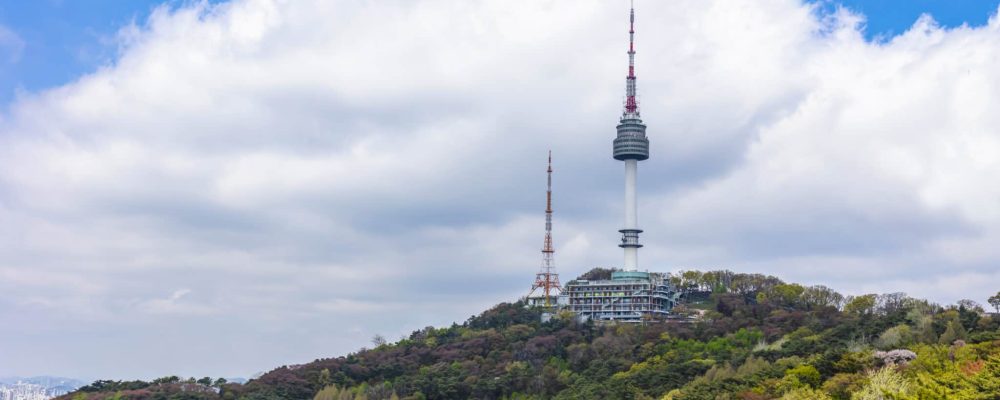
Namsan Seoul Tower stands tall at an impressive height of 236.7 meters above the renowned Namsan Mountain, which itself towers 262 meters above sea level. This iconic structure holds a special place in the hearts of locals and has become a beloved cultural attraction for visitors from around the world. Offering a mesmerizing 360-degree panoramic vista of the bustling metropolis from its observatory, it has gained international recognition through its appearances in numerous Korean TV shows and dramas.
Within the tower’s premises, visitors can explore a plethora of delightful amenities. From a cozy cafe and a splendid restaurant to a cutting-edge VR (virtual reality) experience hall and engaging exhibition halls, there is something for everyone. Among these attractions, international tourists often find themselves drawn to the digital observatory and the Hanbok Culture Experience Hall. The latter provides a unique opportunity to try on traditional Korean attire known as hanbok, adding an extra touch of cultural immersion to their visit. Another popular feature of Namsan Seoul Tower is the “Locks of Love,” where couples and visitors leave thousands of padlocks inscribed with their names on the fence as a symbol of their eternal love.
To reach this captivating landmark, visitors can alight at Chungmuro Station or Donguk University Station and conveniently take a shuttle bus to the tower. Alternatively, for those arriving at Myeongdong Station, a cable car provides a scenic and memorable journey up to the tower. Regardless of the season or time of day, each visit to Namsan Seoul Tower unveils new and enchanting aspects of this vibrant city, making it an experience to cherish.
- Address
- 103 Namsan Park-gil, Yongsan-gu, Seoul (Chungmuro Station, Exit 2)
- Website
- www.seoultower.co.kr
A village of traditional Korean beauty
#Bukchon Hanok Village
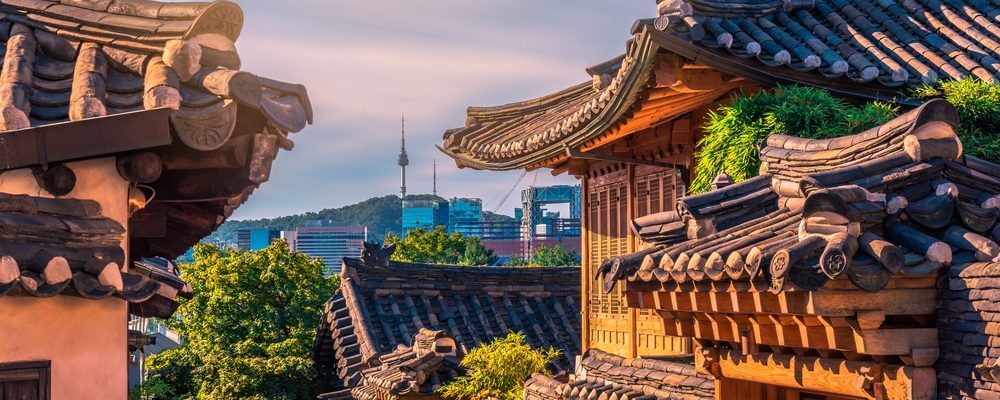
Hanok, the distinctive Korean-style house featuring maru (a spacious wooden floor area for cooling) and ondol (an underfloor heating system), has withstood the test of time. Nestled amidst towering skyscrapers in the bustling downtown area, Bukchon Hanok Village has preserved its charm for over six centuries.
Known as the “northern village,” Bukchon earned its name due to its location north of Cheonggyecheon Stream and Jongno. Originally a residential neighborhood for the ruling class, royal family members, and elected officials, it now boasts nine hundred hanok, including luxurious examples. Strolling through the narrow alleys of the village immerses you in the timeless elegance of this unique architectural style.
While the village remains an inhabited neighborhood, many hanok homes serve as cultural centers, offering visitors the chance to participate in various cultural programs. Engage in activities like creating flower tea, playing the gayageum (a traditional Korean string instrument), or attending muninhwa (Korean portrait painting) classes. Guided walking tours are also available, ensuring an enriching experience. Prior to your visit, be sure to visit the Seoul Hanok website for more information.
- Address
- 37 Gyedong-gil, Jongno-gu, Seoul (Anguk Station, Exit 2)
- Inquiries
- +82-2-3780-0561~5
Picnic among the cherry blossoms and fireworks
#Yeouido Hangang Park
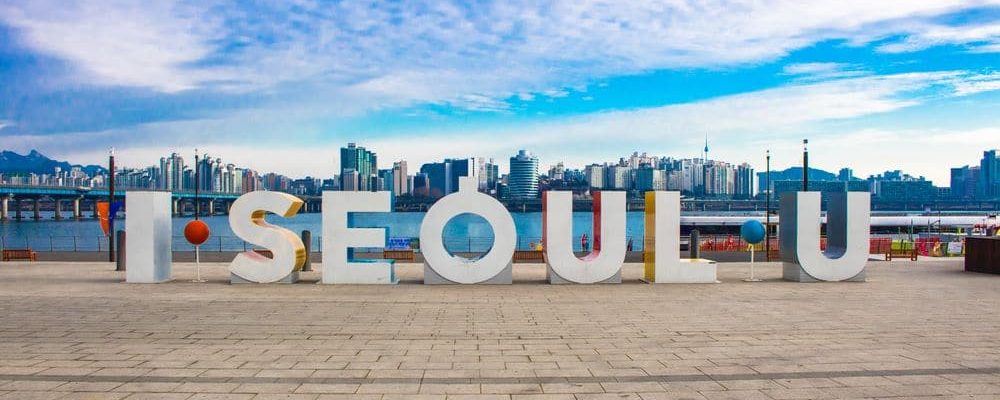
Yeouido, the bustling hub of Korean politics, media, banking, and finance, houses the prestigious National Assembly, financial institutions, and broadcasting stations. At the heart of Yeouido Island lies the captivating Yeouido Hangang Park, stretching 8.4 km from the Hangang Railway Bridge to the picturesque slopes of Saetgang behind the National Assembly. On sun-kissed days, the park beckons both visitors and locals for delightful picnics and leisurely strolls on its lush green lawns.
In April or October, don’t miss the opportunity to visit the park. The Spring Flower Festival takes place in April when the main road is adorned with cherry blossoms, while the Seoul International Fireworks Festival is in October, when the autumn night sky explodes with colorful fireworks. These two events are the most popular of all festivals held in Seoul. There is also a dock for the Hangang Eland Cruise, which brings you on a river cruise down the Hangang River – yet another unforgettable memory in Seoul.
- Address
330 Yeouidong-ro, Yeongdeungpo-gu, Seoul (Yeouinaru Station, Exit 2)
- Inquiries
- +82-2-3780-0561~5
Heaven for shoppers and foodies
#Myeong-dong
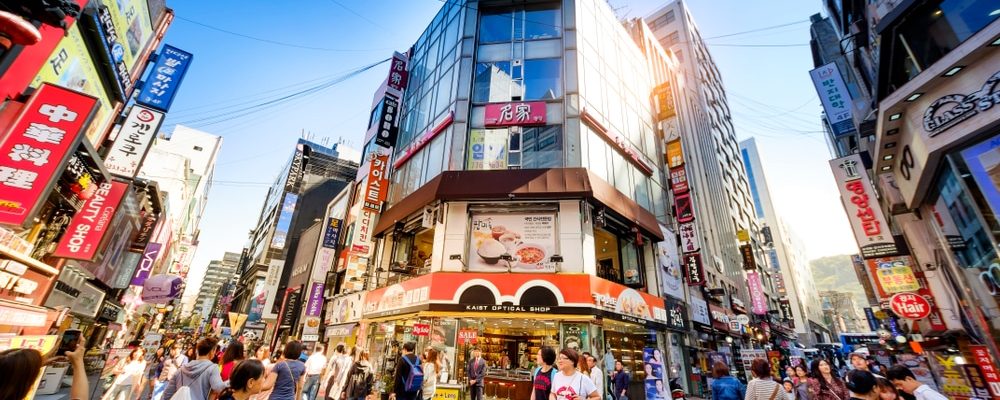
Myeong-dong, a beloved shopping destination since the 1980s, is a haven for fashion enthusiasts. This vibrant district boasts an array of department stores, luxury brand outlets, global SPA brands, and local boutiques, catering to all shopping needs. Explore the treasure trove of proven-effective Korean cosmetics, Korean groceries, and affordable fashion items and accessories sold at bustling street stalls.
For food enthusiasts, Myeong-dong is a paradise of street food. Wander through the pedestrian-friendly streets adorned with rows of stalls, offering a tantalizing array of exotic delicacies prepared with diverse ingredients and recipes. Indulge in these delectable treats that will not only satiate your hunger but also captivate your senses. If you have extra time to spare, visit the historic 120-year-old Myeongdong Cathedral and immerse yourself in the architectural beauty. Additionally, don’t miss the opportunity to explore the collection of Joseon Dynasty hanok (traditional Korean houses) at Namsangol Hanok Village. Myeong-dong is a treasure trove of experiences waiting to be discovered.
- Address
Myeongdong 8-gil, Jung-gu, Seoul (Myeongdong Station, Exit 6)
Alleyways brimming with traditional Korean culture
#Insa-dong
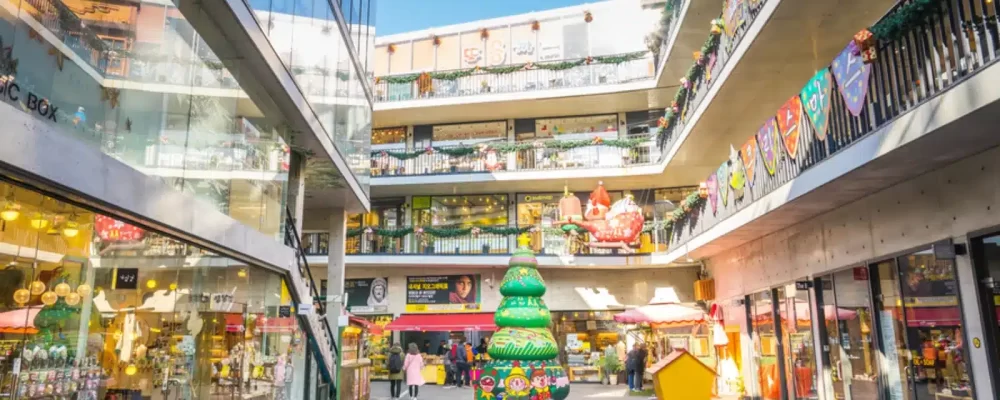
For a delightful immersion into traditional shopping, Insa-dong Street is a must-visit destination. Situated near Tapgol Park in Jongno, Insa-dong is a vibrant neighborhood brimming with artisan craft stores, antique shops, and authentic eateries.
Immerse yourself in the world of traditional Korean art by exploring the numerous galleries that line the streets. Discover intriguing and inspiring items such as munbangsau, the essential tools used by Confucian scholars during the Joseon Dynasty, consisting of a brush, solid ink, traditional paper, and an ink stone. Marvel at the bojagi, a traditional Korean wrapping cloth often crafted in a mesmerizing patchwork style.
Insa-dong offers a variety of exquisite souvenirs and gifts, including spoon and chopstick sets housed in beautiful cases, jewelry boxes adorned with traditional patterns, and both modernized and traditional hanbok attire. To recharge after a day of exploration, unwind at one of the nearby traditional tea houses and savor the flavors of omija, ginseng, jujube, and other authentic teas. Insa-dong Street promises an enchanting journey through Korea’s rich cultural heritage.
- Address
- Insadong-gil, Jongno-gu, Seoul (Jonggak Station, Exit 3)
- Website
- www.hiinsa.com
- Inquiries
- +82-2-734-0222
Open public spaces for Seoulites
#Gwanghwamun Square & Seoul Plaza
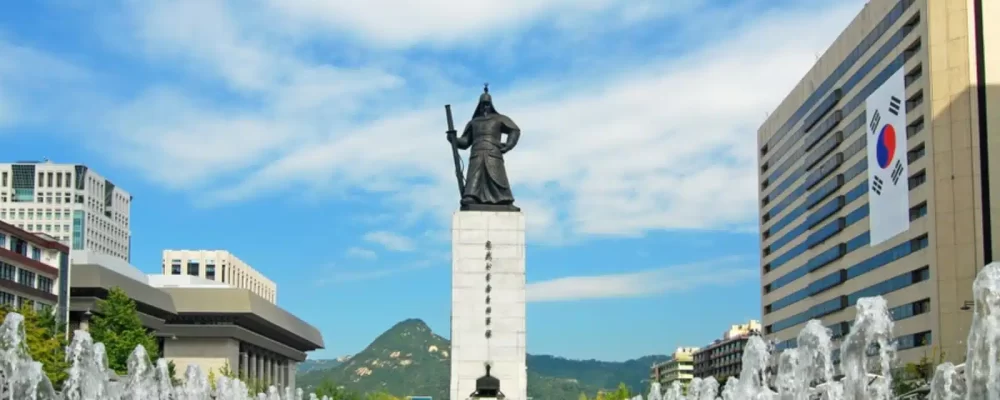
Seoul and Korea have a rich history of vibrant squares that have played significant roles in shaping daily life and witnessing pivotal historic moments. Among them, Gwanghwamun Square and Seoul Plaza stand out as the most iconic and beloved.
Gwanghwamun Square extends in a straight line from the historic Gwanghwamun Gate, the main entrance of Gyeongbokgung Palace, all the way to City Hall, spanning over the picturesque Cheonggyecheon Stream. At the heart of the square, statues of King Sejong the Great and Admiral Yi Sunshin, revered heroes of Korea, proudly stand tall.
Not only is Gwanghwamun Square a symbol of national pride, but it has also been the site of candlelight protests and a vibrant hub for diverse festivals. Below the square, in an area called Haechi Madang, visitors can explore Arisu drinking fountains, an information center, souvenir shops, and a cultural gallery, offering a wealth of experiences.
Seoul Plaza, an oval-shaped expansive lawn located in front of City Hall, serves as a dynamic venue for concerts, festivals, and commemorative events throughout the year. During the 2002 Korea-Japan World Cup, the plaza buzzed with energy as tens of thousands of fans clad in red gathered to cheer on the national team, transforming it into a vibrant hub of support. In winter, the plaza transforms into an enchanting ice-skating rink, while summer invites children to revel in the joy of an outdoor swimming pool.
Both Gwanghwamun Square and Seoul Plaza encapsulate the spirit of Seoul and provide spaces for people to come together, celebrate, and create lasting memories. Whether it’s immersing in the historical significance of Gwanghwamun Square or enjoying the lively atmosphere of Seoul Plaza’s events, these squares offer something for everyone, making them integral parts of the city’s fabric and an essential destination for locals and visitors alike.
-
Gwanghwamun Square
- Address
- 172 Sejong-daero, Jongno-gu, Seoul (Gwanghwamun Station, Exits 1, 2, and 8)
- Website
- gwanghwamun.seoul.go.kr
Asia's largest cultural complex
#Starfield COEX Mall
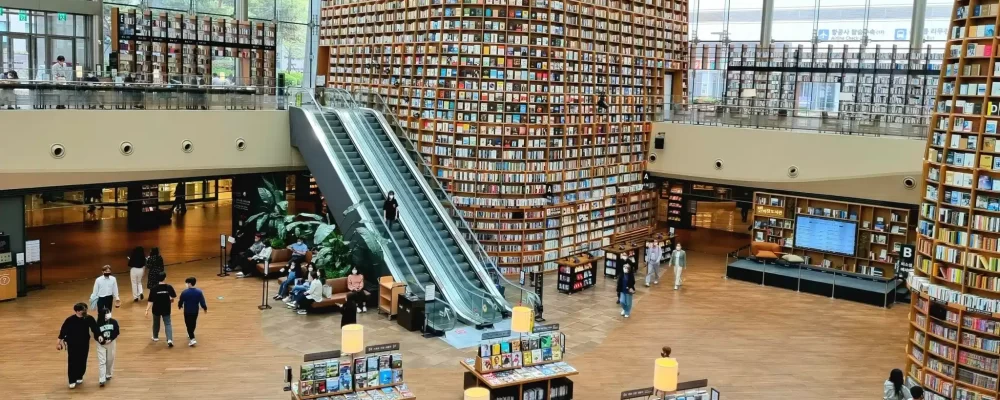
When visiting Korea for business or a conference, it’s highly likely that you’ll find yourself at COEX, renowned for hosting a multitude of fairs, international conferences, and exhibitions throughout the year. If you happen to have a few hours of free time after work and find yourself in the vicinity, make sure to visit the Starfield COEX Mall, an expansive underground shopping mall and cultural complex considered the largest in Asia.
The Starfield COEX Mall offers an array of attractions including a multi-screen movie theater, an enchanting aquarium, a well-stocked bookstore, a department store, cozy cafés, delectable restaurants, and a diverse range of brand stores. Even a full day may not be enough to fully explore the vast expanse of this mall. One of the most popular highlights and a must-visit photo spot is the awe-inspiring Starfield Library.
Prepare to be mesmerized by this unique library, boasting two-story bookshelves towering at an impressive height of 13 meters. The library’s elegant curved design showcases over 70,000 books beautifully displayed, reaching all the way up to the ceiling. Throughout the library, you’ll find tables and chairs conveniently placed, creating comfortable spaces for reading or working on a laptop. Don’t miss the opportunity to immerse yourself in the captivating ambiance of Starfield Library—a true haven for book lovers and a tranquil oasis within the bustling mall.
- Address
- 524 Bongeunsa-ro, Gangnam-gu, Seoul (Samsung Station, Exits 5 and 6)
- Inquiries
- +82-2-6002-5300

